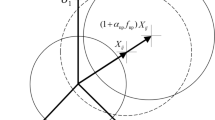Abstract
Under strain-controlled cyclic loading at elevated temperature (650 °C), the low-cycle fatigue behavior of an advanced nickel-based superalloy (RR1000) has been studied. In the current study, a unified mechanics theory (UMT)-based model is presented and applied to predict the fatigue life of nickel-based superalloy (RR1000). Entropy is used as a damage metric in the fatigue life prediction of material in the present study. The entropy generation rate under the mechanical loading conditions is calculated by considering plastic deformation as the governing mechanism for dissipation. Using the UMT, damage in nickel-based superalloy (RR1000) is evaluated to predict low-cycle fatigue life. Also, the stress–strain hysteresis loop prediction has been done at any strain amplitude without making use of curve-fitting phenomenological models. The hysteresis loops can be predicted at any given number of cycles for all strain amplitudes using UMT without doing complete fatigue experiments, which in turn reduces the efforts and costs of the cumbersome fatigue experiments.







Similar content being viewed by others
References
Santecchia, E., Hamouda, A.M.S., Musharavati, F., Zalnezhad, E., Cabibbo, M., El Mehtedi, M., Spigarelli, S.: A review on fatigue life prediction methods for metals. Adv. Mater. Sci. Eng. 2016, 1–26 (2016)
Pretty, C.J., Whitaker, M.T., Williams, S.J.: Thermo-mechanical fatigue crack growth of RR1000. Materials 10(1), 34 (2017)
Child, D.J., Meldrum, J., Onwuarolu, P.: Corrosion-fatigue testing of Ni-based superalloy RR1000. Mater. Sci. Technol. (United Kingdom) 33, 1040–1047 (2017). https://doi.org/10.1080/02670836.2016.1242827
Silva, J.M., Cláudio, R.A., Sousa E Brito, A., Branco, C.M., Byrne, J.: Characterization of Powder Metallurgy (PM) nickel base superalloys for aeronautical applications. Mater. Sci. Forum. 514–516, 495–499 (2006). https://doi.org/10.4028/www.scientific.net/msf.514-516.495
Cheng, A.S., Laird, C.: Fatigue life behaviour of copper single crystals. Part I and II. Fatigue Engng. Mater. Struct. 4, 331–353 (1981)
Tanaka, K., Mura, T.: A dislocation model for fatigue crack initiation 48, 97–103 (1981)
Smith, K.N., Topper, T.H., Watson, P.: A stress–strain function for the fatigue of metals (stress-strain function for metal fatigue including mean stress effect). J Mater. 5, 767–778 (1970). https://doi.org/10.1179/1752270612Y.0000000008
Ontiveros, V., Amiri, M., Kahirdeh, A., Modarres, M.: Thermodynamic entropy generation in the course of the fatigue crack initiation. Fatigue Fract. Eng. Mater. Struct. 40, 423–434 (2017). https://doi.org/10.1111/ffe.12506
Harvey, S.E., Marsh, P.G., Gerberich, W.W.: Atomic force microscopy and modeling of fatigue crack initiation in metals. Acta Metall. Mater. 42, 3493–3502 (1994). https://doi.org/10.1016/0956-7151(94)90481-2
Ren, Y.M., Lin, X., Guo, P.F., Yang, H.O., Tan, H., Chen, J., Li, J., Zhang, Y.Y., Huang, W.D.: Low cycle fatigue properties of Ti-6Al-4V alloy fabricated by high-power laser directed energy deposition: experimental and prediction. Int. J. Fatigue. 127, 58–73 (2019). https://doi.org/10.1016/j.ijfatigue.2019.05.035
Kumar, J., Sundara Raman, S.G., Kumar, V.: Analysis and modeling of thermal signatures for fatigue damage characterization in Ti–6Al–4V titanium alloy. J. Nondestruct. Eval. 35, 1–10 (2016). https://doi.org/10.1007/s10921-015-0317-5
Boltzmann, L.: Ableitung des Stefan’schen Gesetzes, betreffend die Abhängigkeit der Wärmestrahlung von der Temperatur aus der electromagnetischen Lichttheorie. Ann. Phys. (1884). https://doi.org/10.1002/andp.18842580616
Basaran, Cemal, Y.: A Thermodynamic Framework for Damage Mechanics of Solder Joint. J. Electron. Packag. Trans. ASME. 120, 379–384 (1998)
Basaran, C.: Entropy based fatigue, fracture, failure prediction and structural health monitoring. Entropy 22, 1–4 (2020). https://doi.org/10.3390/e22101178
Basaran, C.: Introduction to Unified Mechanics Theory with Applications.
Bin Jamal M, N., Kumar, A., Lakshmana Rao, C., & Basaran, C. (2020). Low cycle fatigue life prediction using unified mechanics theory in Ti-6Al-4V alloys. Entropy, 22(1), 24.
Bin, N., Jamal, M., Rao, C.L., Basaran, C.: A unified mechanics theory-based model for temperature and strain rate dependent proportionality limit stress of mild steel. Mech. Mater. 155, 103762 (2021). https://doi.org/10.1016/j.mechmat.2021.103762
Basaran, C., Nie, S.: An irreversible thermodynamics theory for damage mechanics of solids. Int. J. Damage Mech. 13, 205–223 (2004). https://doi.org/10.1177/1056789504041058
Basaran, C.: Introduction to Unified Mechanics Theory with Applications. Springer International Publishing
Zhao, L.G., Tong, J., Vermeulen, B., Byrne, J.: On the uniaxial mechanical behaviour of an advanced nickel base superalloy at high temperature. Mech. Mater. 33, 593–600 (2001). https://doi.org/10.1016/S0167-6636(01)00071-0
Temfack, T., Basaran, C.: Experimental verification of thermodynamic fatigue life prediction model using entropy as damage metric. Mater. Sci. Technol. (United Kingdom) 31, 1627–1632 (2015). https://doi.org/10.1179/1743284715Y.0000000074
Peressini, A.L., Uhl, J.J., Sullivan, F.E.: Least Squares Optimization. 133–155 (1988). https://doi.org/10.1007/978-1-4612-1025-2_4
Acknowledgements
The authors would like to thank the specific lab of Defence Metallurgical Research Laboratory (DMRL), Defence Research and Development Organization (DRDO), India, for funding the current work.
Author information
Authors and Affiliations
Corresponding author
Ethics declarations
Conflict of interest
The authors declare that they have no conflict of interest.
Additional information
Publisher's Note
Springer Nature remains neutral with regard to jurisdictional claims in published maps and institutional affiliations.
Rights and permissions
About this article
Cite this article
Kumar, A., Jamal Mankarathodi, N.B. & Chebolu, L.R. Fatigue life prediction in nickel-based superalloys using unified mechanics theory. Int J Adv Eng Sci Appl Math 13, 360–367 (2021). https://doi.org/10.1007/s12572-021-00296-8
Accepted:
Published:
Issue Date:
DOI: https://doi.org/10.1007/s12572-021-00296-8




